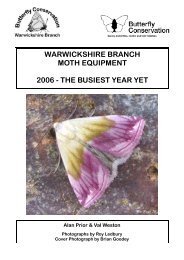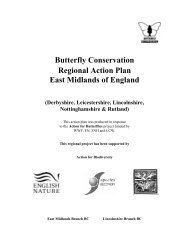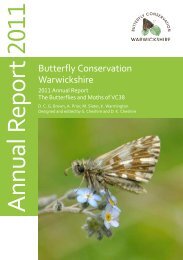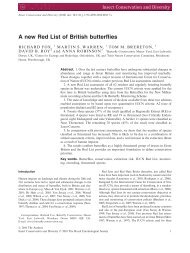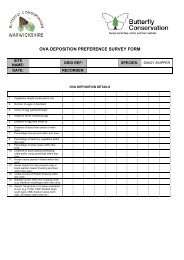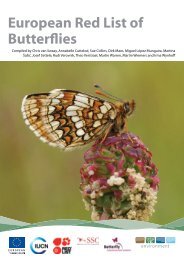2007 Magazine Version 05.indd - Butterfly Conservation Warwickshire
2007 Magazine Version 05.indd - Butterfly Conservation Warwickshire
2007 Magazine Version 05.indd - Butterfly Conservation Warwickshire
You also want an ePaper? Increase the reach of your titles
YUMPU automatically turns print PDFs into web optimized ePapers that Google loves.
etween <strong>Butterfly</strong> <strong>Conservation</strong> and farmers and landowners. Parallel with this activity<br />
Mike Slater was working hard to acquire a landfill site at Ryton as a branch reserve.<br />
This took several years of diplomatic effort both with the owners LaFarge and with<br />
<strong>Butterfly</strong> <strong>Conservation</strong> staff and it was not until 2004 that we were able to make the<br />
possibility of managing our own reserve common knowledge. We hope to be able to<br />
officially open the reserve this spring.<br />
Mike has also been working hard behind the scenes with <strong>Warwickshire</strong> Wildlife Trust<br />
to bring to fruition the far reaching Princethorpe woodland project, in which all the<br />
woodland in central <strong>Warwickshire</strong> will eventually become linked so that species can<br />
easily travel throughout the habitat, and all will be managed for the benefit of wildlife.<br />
We are already seeing results: Wood White and Silver-washed Fritillary butterflies have<br />
significantly increased in numbers, whereas before management took place these<br />
species were on the point of being declared extinct in the county. The<br />
Princethorpe woodland complex is also home to several<br />
rare moths such as Light Orange Underwing, Great<br />
Oak Beauty, Cloaked Carpet and Mere Wainscot.<br />
The publication of David Brown’s book, The<br />
Larger Moths of <strong>Warwickshire</strong>, was a highlight<br />
of 2006, and it was during this year that Jane<br />
Ellis started her wide ranging project to list,<br />
classify and ultimately conserve all the<br />
brownfield sites in the West Midlands.<br />
The landowners of several sites have<br />
been contacted and management<br />
plans drawn up. These measures<br />
will benefit all species found in<br />
such habitats but especially the<br />
Dingy Skipper and, hopefully,<br />
the Small Blue.<br />
Photograph © Debbie Hibbitt <strong>2007</strong><br />
Above: A mating pair of Small Blue butterflies<br />
What of the future? I would<br />
expect conservation efforts to<br />
continue to move away from the<br />
exclusiveness of nature reserves<br />
and to further embrace the wider<br />
countryside bringing yet more farmers<br />
and landowners into the fold. However,<br />
this will depend as much on the<br />
government’s grant scheme for farmers<br />
and landowners as on efforts made by<br />
<strong>Butterfly</strong> <strong>Conservation</strong>. At present these<br />
are in our favour, long may they remain so.<br />
Margaret Vickery<br />
Chairman<br />
6<br />
<strong>Butterfly</strong> <strong>Conservation</strong> <strong>Warwickshire</strong> Branch <strong>Magazine</strong> <strong>2007</strong>




